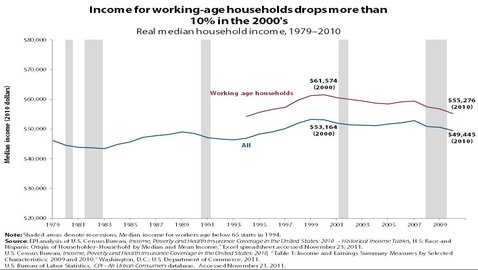American Workers In 1979 Were Better Off Than Those Today: Where Have The Jobs Disappeared?
Post Views 3
Given that the workforce today is older and better educated than what it was three decades ago, it might be logically assumed that they would get better and higher pay and also be entitled to better benefits and that jobs would be easily available to them and that their share in terms of better emoluments and facilities would be on par with an optimistic job expectancy.
Reports vindicate claims that the workplace today is more educated today than then, revealing that in 2010 more than a third, 34 percent of theworkers, had four-year college degrees, whilst only 19 percent of them had it in 1979.
Unfortunately, things are not turning out they should logically be on the contrary they are taking a reverse turn. According to a paper brought by the Center for Economic and Policy Research, the economy is not generating as many as good jobs as it did three decades ago. Simply put, it means that three years ago there were more good jobs on offer than there are today.
What then is a good job? The authors of the paper, John Schmitt, a senior economist at CEPR, and Janelle Jones, a research assistant, said that a good job was one that earned well and provided workers with means to live a decent desired life, one that provided him with adequate health insurance to take care of the uncertainties of life and enable him to save enough to provide a cozy cushion for his retirement.
The authors say that they have based their calculations of the Census Bureau’s Current Population Survey data, to put tangible figures in dollar terms to these factors to asses exactly what a ‘good job’ would mean in materialistic terms on what household earnings, health coverage and retirement plan would be worth in monetary value.
The job, the authors surmise, should pay at least $18.50 an hour, that’s about $3,084 per month, or about $37,000 annually. That would be on par with what the male workers received in 1979, in hourly-pay, adjusted to prevalent rates of inflation. In 2010, about 47% of workers were higher than that $18.50-an-hour yardstick, up from 40.6% in 1979 — a slender improvement.
The second factor of what makes a god job is employer-sponsored health insurance, in which the employer bears at least some part of the employees’ premium expenses. The authors say that there is a drop in what the employers contributed towards the premium in 1979 and now, noting that between 1979 and 2010, employer-provided coverage fell considerably by as much as almost 13 percentage points.
The third factor is the employer-sponsored retirement and pension plans.
Based on these three factors, the authors concluded that less than a quarter of all jobs in 2010, a mere 24. 6 percent could be categorized as good jobs. In 1979 it was 2 percent better. So despite a better educated workforce and a 63% increase in per-person GDP, the share of good jobs in the economy fell over 2.8 percentage points over the last thirty years.
Why is the economy failing to generate good jobs and why is there a deficit gap in numbers even though, rationally there should have been substantial improvement. One common reason that analyst bandy about is that there is a dearth of skilled employers and there are hundreds of thousands of job openings remaining unfilled because the companies are unable to find qualified candidates.
However, Schmitt says that this is merely an excuse and not the real reason and the real cause is simply because of the proven supply-and-demand theory. He says that if there were a lesser number of skilled workers, companies would poach on them and entice and lure them with higher wages and better benefits than what there were getting at their current workplaces. However, he said, wages have remained virtually stagnant over the years.
He said, “If that were true and widespread, we’d see wages of workers rising, because employers would try to steal away qualified workers from other employers. We’re not seeing that in the data — we’re not seeing an increase in wages relative to last year, or the year before, or before that.”
The differences have evolved over the years for a variety of reasons and were inevitable and unavoidable. This he says is owing to “deterioration in the bargaining power of workers, especially those at the middle and the bottom of the income scale.”
The reason why the workers lost their bargaining power he says was owing to the restructuring of the labor market, a process that commenced in the late seventies and continues till date. Moreover, unions lost their hold on the workers and apart from attracting employees from the public-sector have failed to attract non-public employees. The number of unionized workers has fallen drastically.
New federal and state laws saw many state and local government jobs privatized even as many large industries were deregulated. Ironically, adjusted to inflation, the minimum wage that the workers receive today is 15 percent lower than was they received in 1979.
Schmitt says that the recession has brought in its share of problems and it hurts badly, but the trends were ‘longstanding.’ If notice had been taken of “falling unionization rates, deregulation, trade policy, immigration and an obsession with inflation at the expense of job creation,” that are the prime cause of current situation the scenario would not have been so regrettable.
The report basically says the educational levels have gone up, but over the last thirty years, it has gotten us nowhere. The value of the college education has regressed and we are being paid less than what workers received then, sad and deplorable, to say the least.
American Workers In 1979 Were Better Off Than Those Today: Where Have The Jobs Disappeared? by Harrison Barnes


 7 Best Summer Jobs for Students
7 Best Summer Jobs for Students  Get Your Hands Dirty with WWOOF
Get Your Hands Dirty with WWOOF  More Companies Are Offering College Tuition to Employees
More Companies Are Offering College Tuition to Employees  Mixing Artistic Minds with Science in Switzerland
Mixing Artistic Minds with Science in Switzerland  Calling All Artists to the South Pole
Calling All Artists to the South Pole  Head to Marfa, Texas for Solitude in Your Artwork
Head to Marfa, Texas for Solitude in Your Artwork  50 Cool Companies to Work For
50 Cool Companies to Work For  Get Busy Building a National Park in Chile
Get Busy Building a National Park in Chile